Proper alignment is essential when using phone-telescope mounts, as even slight misalignment causes blurry images or vignetting. Your smartphone’s camera limitations mean results won’t match dedicated astronomy cameras, despite premium mounts ($25-$100+) offering better stability. Check compatibility with your telescope eyepiece size (1.25″ or 2″) and phone model before purchasing. Specialized astrophotography apps help maximize results by enabling manual settings. Patience and practice bridge the gap between expectations and impressive celestial photography you’ll soon capture.
Alignment Challenges: Why Perfect Phone Positioning Matters

Why does perfect alignment matter so much when mounting your phone to a telescope? The answer lies in image quality. When you’re smartphone using techniques for astrophotography, coaxial alignment between your phone’s camera and the telescope eyepiece is essential for capturing clear, centered images of celestial objects.
The alignment challenges you’ll face include vignetting (darkened edges), blurry images, and missed targets. Even slight misalignment can ruin an otherwise perfect shot. Many adapters offer adjustable angles to help you achieve ideal positioning, which you should take advantage of.
Before capturing, secure your smartphone firmly in the adapter to prevent movement during exposure. This stability is especially vital for long-exposure shots where any slight vibration can blur your celestial subject.
Image Quality Trade-offs of Smartphone Adapters
Although smartphone adapters have democratized astrophotography, they come with notable image quality compromises you should understand before investing. Your phone camera’s smaller sensor and fixed lens limitations will become apparent when capturing celestial objects, especially compared to dedicated astronomy equipment.
- Hardware limitations – Even high-end smartphones can’t match dedicated astrophotography cameras in capturing faint celestial details, resulting in grainier images with less dynamic range.
- Alignment challenges – Imperfect positioning affects focus quality and can considerably degrade your final images.
- Software solutions – Specialized astrophotography apps help mitigate some issues by offering manual controls for exposure, ISO, and focus, but they can’t overcome fundamental hardware constraints.
The quality of your results will directly reflect both your telescope’s capabilities and your smartphone’s camera technology.
Compatibility Issues Between Telescopes and Phone Models

When selecting a smartphone adapter for your telescope, you’ll need to navigate a maze of compatibility considerations that can make or break your astrophotography experience.
Not all adapters work universally, so verify that your choice fits your telescope’s eyepiece size—either 1.25″ or 2″—before purchasing.
Always check compatibility between your adapter and telescope eyepiece size before purchase to avoid wasted investment.
While some models like the Universal Astro 70mm Refractor include built-in smartphone adapters, most telescopes require separate mounts.
Compatibility issues often arise from eyepiece design variations; Explore Scientific eyepieces, for instance, tend to exceed standard sizes and may not fit all adapters.
Specialized adapters like the TeleVue FoneMate work only with specific diameter measurements.
Before investing, check reviews from users with your particular phone model to avoid disappointment with your telescope-smartphone pairing.
Budget-Friendly Solutions vs. Premium Mounts: Worth the Investment?
You’ll find budget phone-to-telescope mounts around $25 that work for casual stargazing, while premium options like the TeleVue FoneMate offer superior alignment and broader compatibility.
The difference shows in your final images, as higher-quality mounts provide more stability and precision, resulting in clearer celestial photographs.
Your decision between DIY solutions, budget commercial options, or premium mounts should balance your astrophotography goals against your willingness to invest in equipment that will deliver consistently better results.
Cost vs. Performance
While exploring the world of smartphone telescope adapters, you’ll quickly discover a wide price range that begs the question: is a premium mount worth the extra investment? The cost vs. performance equation depends largely on your imaging goals and frequency of use.
Budget options like the $24.99 Gosky brackets deliver decent results for casual phone photographers, but premium mounts such as the TeleVue FoneMate offer superior alignment capabilities and compatibility with various eyepieces.
Consider these factors when deciding:
- Usage frequency – occasional snapshots work fine with budget mounts
- Image quality requirements – premium mounts yield markedly better results with high-quality telescopes
- Long-term value – premium options often save time and frustration through improved durability and ease of use
DIY vs. Commercial
The cost-performance balance extends naturally to the choice between creating your own phone mount or purchasing a ready-made solution.
DIY solutions offer significant savings—typically under $25 for 3D printed designs or simple duct tape arrangements—compared to commercial options ranging from $50 to $150.
While budget-friendly DIY approaches work well for occasional stargazing, commercial mounts like the TeleVue FoneMate and Celestron NexYZ provide undeniable advantages.
You’ll get better compatibility with various eyepiece sizes, more secure connections, and improved alignment precision—benefits that matter for serious astrophotography.
For middle ground, consider affordable options like Gosky adapters, which deliver good functionality without breaking the bank.
Your decision ultimately depends on usage frequency: DIY serves occasional needs, while commercial mounts offer the durability and reliability you’ll appreciate for regular celestial photography sessions.
The Learning Curve: Mastering Phone-to-Telescope Photography

Mastering phone-to-telescope photography requires understanding essential capture techniques, starting with proper alignment of your smartphone’s camera lens with the eyepiece.
You’ll need to experiment with your phone’s camera settings, adjusting ISO and shutter speed to adapt to different celestial viewing conditions.
Specialized astrophotography apps can greatly enhance your imaging results, offering advanced features like time-lapse recording and post-processing tools that transform basic snapshots into impressive astronomical photographs.
Capture Technique Fundamentals
Starting on your phone-to-telescope photography journey requires patience as you navigate the initial learning curve. The fundamentals of capture technique begin with proper equipment setup and strategic image acquisition.
First, make sure your smartphone adapter securely attaches to your telescope eyepiece, confirming size compatibility before proceeding.
- Focus first – Always adjust your telescope’s focus on your target celestial object before aligning your smartphone with the eyepiece lens.
- Utilize specialized tools – Leverage astrophotography apps that offer adjustable ISO and shutter speed controls for best image quality.
- Shoot in multiples – Capture several images of the same object to overcome atmospheric turbulence and identify your best shots.
Experiment with both manual and automated alignment methods as you refine your technique and develop your skills.
Software Tools Overview
While traditional astronomy may rely on the naked eye, effective phone-to-telescope photography depends heavily on specialized software applications. The right astrophotography apps can transform your smartphone camera into a powerful celestial imaging tool by offering manual exposure controls for ISO and shutter speed adjustments.
Most quality apps include built-in tutorials that guide you through celestial navigation basics and recommend ideal settings for different astronomical subjects. You’ll want to experiment with these settings, capturing multiple shots of the same object to determine what works best for your specific equipment combination.
As you progress, pay close attention to alignment between your smartphone camera and telescope eyepiece. The software can help you fine-tune these adjustments, but understanding your phone’s camera settings remains essential for capturing the crisp, detailed images you’re aiming for.
Extending Your Phone’s Capabilities With Astrophotography Apps
Once you’ve securely mounted your smartphone to a telescope, specialized astrophotography apps can greatly transform your device into a powerful imaging tool.
These applications reveal deep sky astrophotography potential by giving you manual control over critical settings like ISO, shutter speed, and exposure time—parameters that considerably impact your ability to capture distant celestial objects.
Take control of your cosmic canvas by unlocking manual settings—the true gateway to deep space imaging mastery.
Many apps extend your phone’s capabilities beyond its native camera app through:
- Live stacking technology – combining multiple exposures in real-time to reduce noise and enhance detail
- Object tracking features – helping you maintain perfect alignment with moving celestial targets during long exposures
- Time-lapse functionality – capturing the dynamic movement of planets, stars, and other objects over extended periods
Don’t underestimate how the right software can elevate your smartphone astrophotography from simple snapshots to stunning celestial portraits.
Real User Results: Expectations vs. Reality for Beginner Astronomers
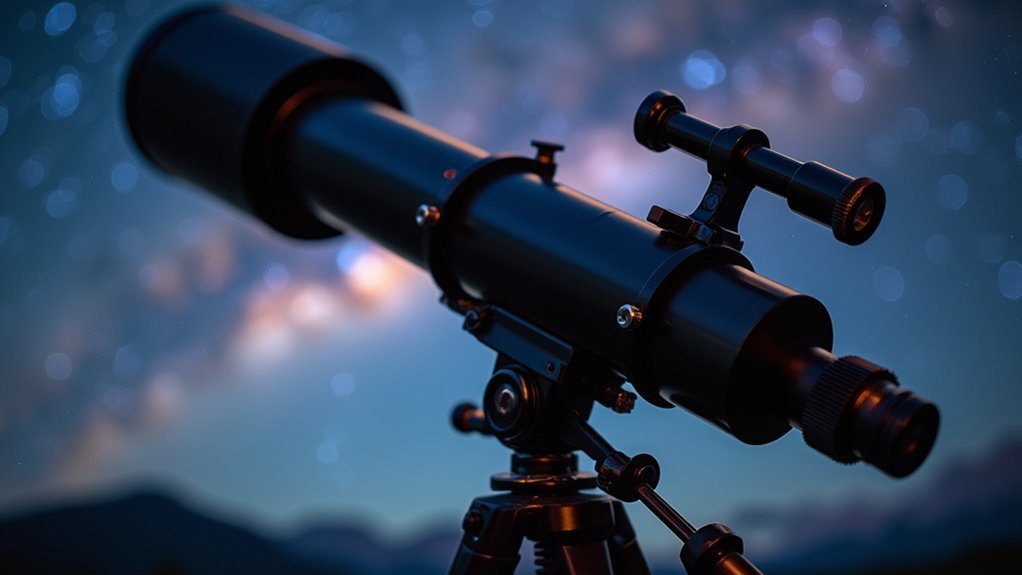
When new stargazers first mount their smartphones to telescopes, their expectations often collide with reality.
While mounts can improve your images compared to handheld attempts, many users struggle with aligning their phone camera properly with the eyepiece, resulting in frustrating blurry shots.
Despite attractive price ranges for budget mounts, compatibility issues frequently arise with larger eyepieces, limiting your viewing options.
Planetary imaging shows mixed results—you’ll likely capture recognizable images of the Moon or Saturn, but quality varies dramatically based on your phone’s camera capabilities and telescope specifications.
To maximize your chances of success, experiment with different camera settings like ISO and shutter speed.
Taking multiple shots also increases your odds of capturing that perfect celestial moment, even if results don’t always match your initial expectations.
Frequently Asked Questions
How to Use Phone Mount on Telescope?
You’ll need to align your telescope first, attach the phone adapter to the eyepiece, position your smartphone correctly, secure it firmly, adjust focus for clarity, and use astrophotography apps for better images.
How to Take Pictures Through a Telescope With a Phone?
You’ll need to align your telescope first, then attach a compatible smartphone adapter to the eyepiece. Align your phone’s camera with the eyepiece, focus carefully, and use astrophotography apps for better results.
What Does a Telescope Mount Allow You to Do?
A telescope mount allows you to track celestial objects, preventing star trails during long exposures. You’ll keep targets centered at high magnifications and make precise adjustments either manually or with motorized controls for smoother viewing.
What Is the App That Turns Your Phone Into a Telescope?
No single app turns your phone into a telescope. Apps like SkySafari, Stellarium, and NightCap enhance your phone’s camera capabilities when used with telescopes, offering features like star charts and specialized camera controls.
In Summary
Your smartphone can transform your stargazing experience, but it won’t replace dedicated astronomy equipment. When choosing a mount, prioritize stability and alignment over price, and pair it with quality apps for best results. Be patient—there’s a learning curve, but with practice, you’ll capture impressive cosmic images. Remember, even with limitations, phone-to-telescope photography opens up the universe in your pocket.
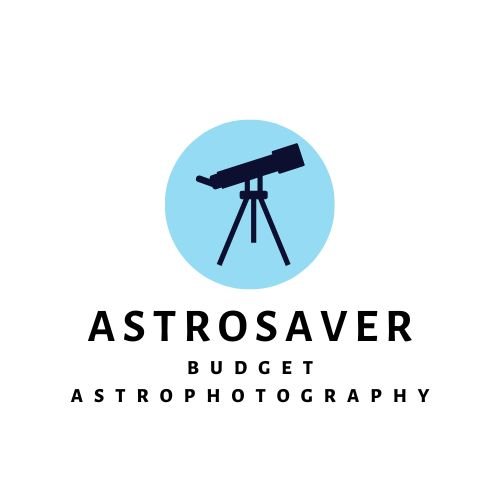
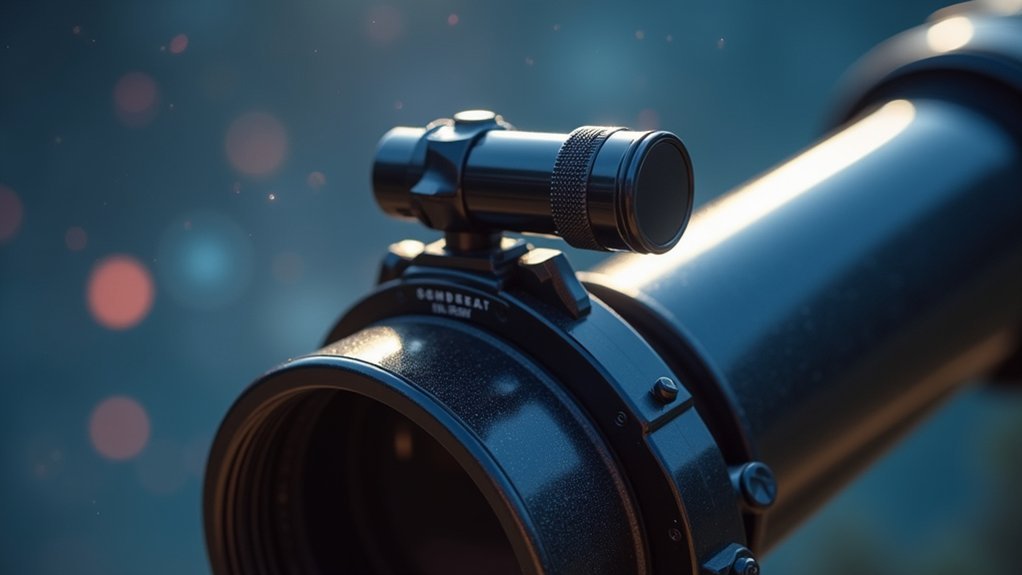
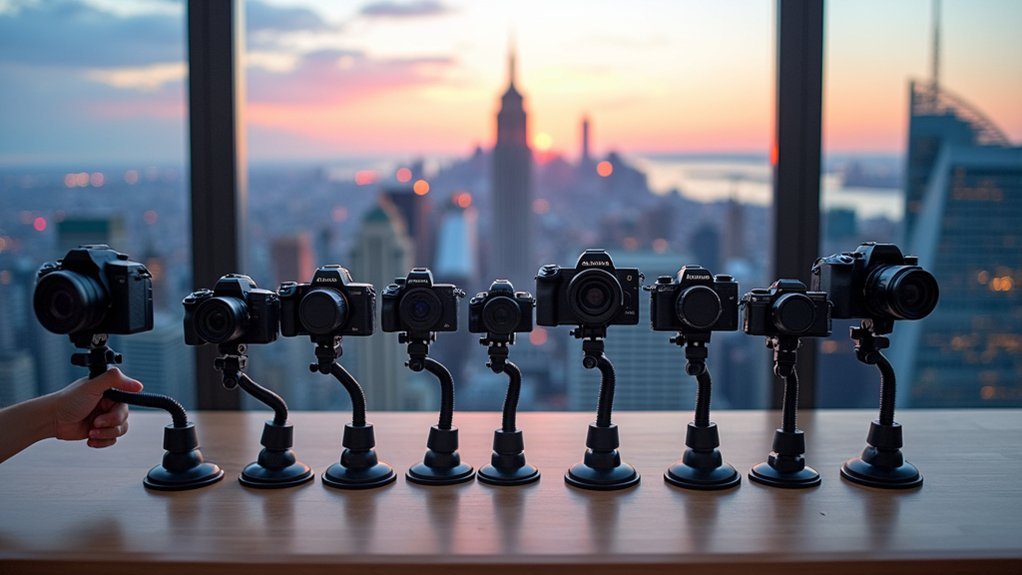
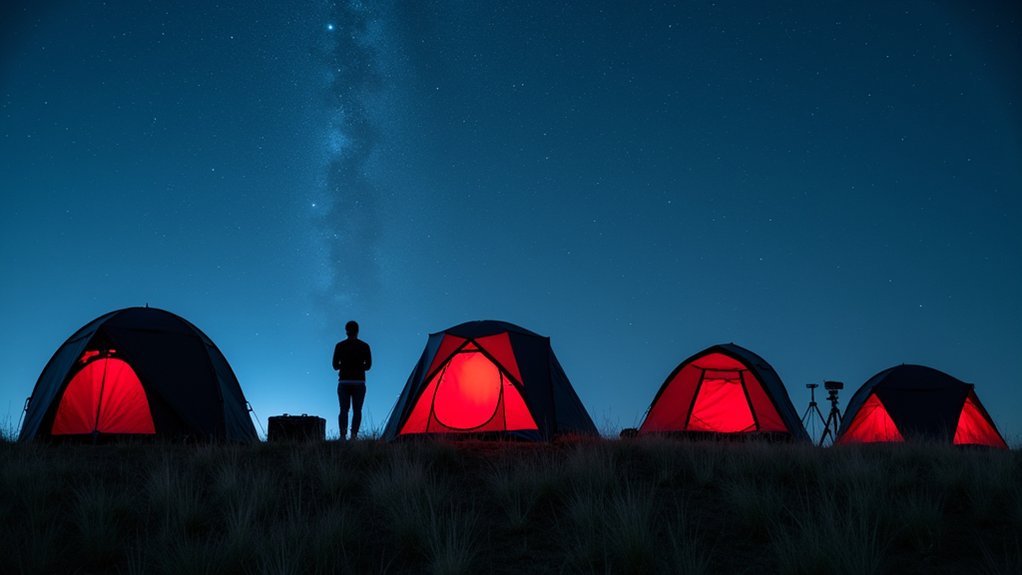
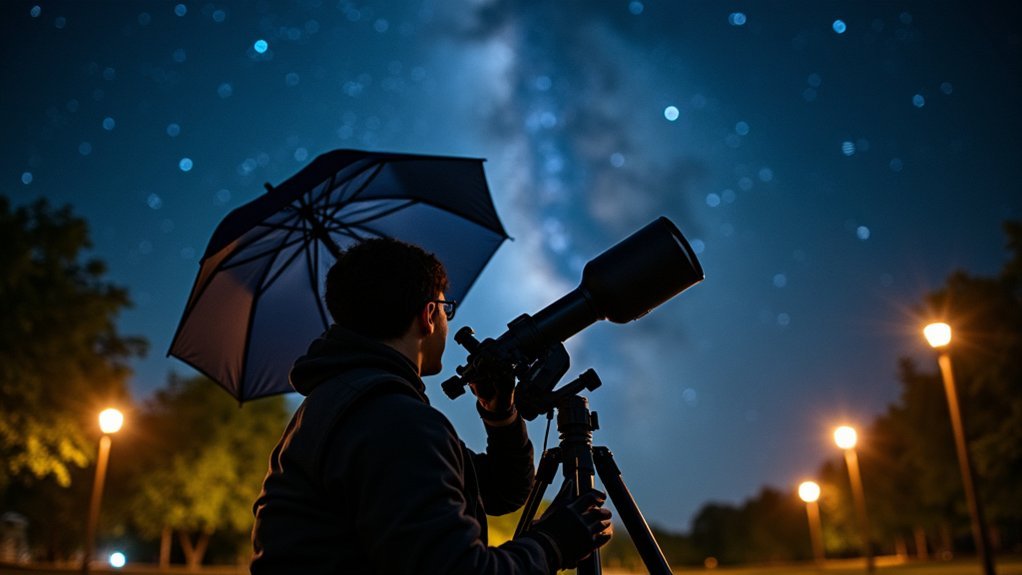
Leave a Reply